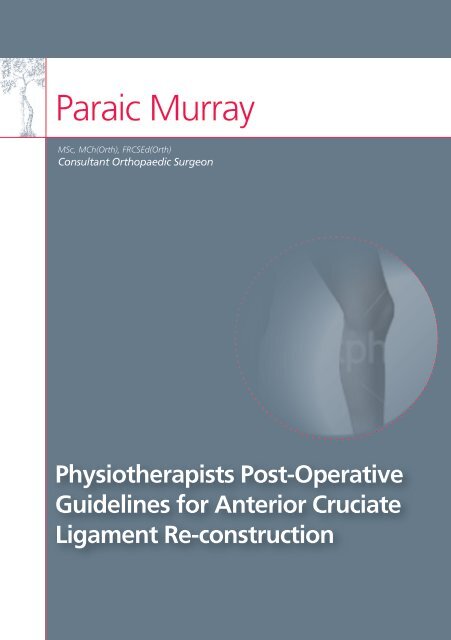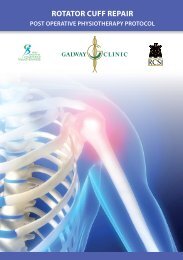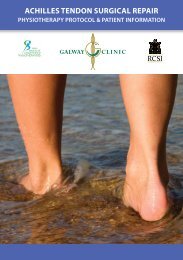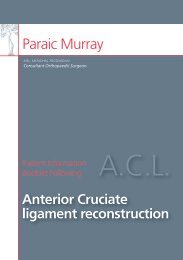Paraic Murray - Galway Clinic
Paraic Murray - Galway Clinic
Paraic Murray - Galway Clinic
Create successful ePaper yourself
Turn your PDF publications into a flip-book with our unique Google optimized e-Paper software.
<strong>Paraic</strong> <strong>Murray</strong><br />
MSc, MCh(Orth), FRCSEd(Orth)<br />
Consultant Orthopaedic Surgeon<br />
Physiotherapists Post-Operative<br />
Guidelines for Anterior Cruciate<br />
Ligament Re-construction
Contents<br />
Rehabilitation Guidelines 4<br />
Phase 0 – Pre-operative Recommendations 5<br />
Phase 1 – Immediate Post Operative Phase 6<br />
Phase 2 – Early Rehabilitation Phase 8<br />
Phase 3 – Strengthening and Control Phase 10<br />
Phase 4 – Advanced Training Phase 12<br />
Phase 5 – Return to Sport Phase 13
Rehabilitation Guidelines<br />
The following Anterior Cruciate Ligament (ACL) reconstruction rehabilitation guidelines are<br />
based on a review of the randomised controlled trials related to ACL rehabilitation. For the<br />
many aspects of the ACL rehabilitation where there are either no studies that qualify as “best<br />
evidence” or the number of studies are too few for confident conclusions to be drawn, the<br />
recommendations are based upon the guidance of the Multicenter Orthopaedics Outcomes<br />
Network (MOON) panel of content experts.<br />
The guidelines have been developed to service the spectrum of ACL injured people from<br />
the non- to the elite athlete. For this reason the guidelines are not prescriptive and example<br />
exercises only are given. Each programme should be tailored to meet the individual needs<br />
of the patient.<br />
Progression from one phase to the next is based on the patient demonstrating readiness by<br />
achieving functional criteria rather than the time elapsed since surgery. The timeframes<br />
quoted here after each phase are approximate times for the average patient, NOT guidelines<br />
for progression. Some patients will be ready to progress sooner while others will take longer.<br />
Phase 0: Pre-operative Recommendations<br />
• Normal Gait<br />
• Active Range of Movement (ROM) 0 to 120 degrees<br />
• Strength: Can Straight Leg Raise (SLR) with no lag x 20<br />
• Minimal effusion<br />
• Patient education on post-operative exercises and need for compliance<br />
• Education in mobilisation with crutches<br />
• Wound care instructions *<br />
* Wound Care: Wool and crepe bandage is reduced on Day 1.<br />
The primary dressings remain in situ even if blood stained, and must remain dry, until Day 10<br />
The aim is to ensure that the sterile wound and any exudate remain sterile. A dressing when<br />
dry even though blood stained acts as an efficient barrier to microbes.<br />
4 5
Phase 1: Immediate Post-operative Phase<br />
(approximate time frame 1 day to 2 weeks Post-operation)<br />
Goals<br />
• Full knee extension<br />
• Good quadriceps control (> 20 no lag SLR)<br />
• Minimize pain<br />
• Minimize swelling<br />
• Normal Gait pattern<br />
Crutch Use: Partial weight bearing<br />
Crutch Discharge:<br />
Criteria: Normal Gait pattern.<br />
Ability to ascend/descend stairs without noteworthy pain or instability<br />
(reciprocal stair climbing)<br />
Cryotherapy: First 24hrs or until acute inflammation is controlled: every hour for 15mins.<br />
After acute inflammation is controlled: 3 times a day for 15 minutes<br />
Exercise suggestions<br />
ROM<br />
• Extension: Low load, long duration (~ 5 minutes) stretching (e.g. heel prop, prone hang<br />
minimizing co-contraction and nocioceptor response)<br />
• Flexion: Wall slides (see squats), heel slides, seated assisted knee flexion,<br />
bike: half revolutions for range<br />
Muscle Activation/Strength<br />
• Quadriceps sets emphasising vastus lateralis and vastus medialis activation<br />
• SLR emphasising no lag<br />
• Double-leg quarter squats (< 45° only) against the wall<br />
• Standing theraband resisted terminal extension – closed kinetic chain<br />
• Standing theraband, *hamstrings – closed kinetic chain<br />
• Side-lying hip adduction/abduction (avoid adduction movement in this phase with<br />
concomitant grade I-II Medial Collateral ligament injury)<br />
• Quadriceps and Hamstring co-contraction supine<br />
• Prone hip extension<br />
• Ankle pumps with theraband<br />
• Heel raises (calf press)<br />
• Calf stretches<br />
* Avoid hamstring curls (open chain) x 3–4 weeks<br />
Criteria for progression to Phase 2<br />
• 20 x no lag SLR<br />
• Normal independent gait<br />
• Active ROM 0-110 degrees<br />
6 7
Phase 2: Early Rehabilitation Phase<br />
(Approximate time frame: 2 to 6 weeks)<br />
Goals<br />
• Full ROM<br />
• Improve muscle strength-able to perform a unilateral step down to 45 degrees knee<br />
flexion, with neutral pelvic alignment<br />
• Progress neuromuscular retraining-able to maintain on a soft surface, a single leg mini dip,<br />
knee unlocked for 15 seconds<br />
Exercise sugestions<br />
ROM<br />
• Low load, long duration stretch (assisted as necessary)<br />
• Heel slides, wall slides<br />
• Heel prop/prone hang (minimize co-contraction/nociceptor response)<br />
• Bike (half revolutions for range > riding with low seat height)<br />
• Flexibility stretching all major groups<br />
Strengthening<br />
Quadriceps:<br />
• Mini-squats/wall squats<br />
• Step up’s<br />
• Step downs low step<br />
• Leg press<br />
• Quadriceps terminal knee extension with theraband-standing<br />
Hamstrings:<br />
• Hamstring with theraband, closed kinetic chain<br />
Other Musculature:<br />
• Hip adduction/abduction: SLR or with equipment<br />
• Standing heel raises: progress from double to single leg support<br />
• Seated calf press against resistance<br />
• Multi- hip machine in all directions with proximal pad placement<br />
Neuromuscular Training<br />
• Wobble board<br />
• Rocker board<br />
• Single-leg stance with or without equipment (e.g. instrumented balance system)<br />
• Sliding board<br />
Cardiovascular<br />
• Bike<br />
• Elliptical trainer<br />
Criteria for progression to Phase 3<br />
• Full ROM<br />
• Minimal effusion/pain<br />
• Functional strength and control in daily activities<br />
• International Knee Documentation Committee (IKDC) Question 10 (global Rating of<br />
Function) score of >7<br />
8 9
Phase 3: Strengthening & Control Phase<br />
(Approximate time frame; 7 to 12 weeks)<br />
Goals<br />
• Maintain full ROM<br />
• Running without pain or swelling<br />
• Hopping without pain, swelling or giving way<br />
• Limb Symmetry Index (LSI) of knee flexors up to 70% of non-operated side( Divide 1<br />
repetition Maximum (1RM)of involved by 1RM of uninvolved leg)<br />
Exercise sugestions<br />
Strengthening<br />
• Squats<br />
• Leg press<br />
• Hamstring closed kinetic chain with theraband<br />
• Knee extension 90-0 degrees<br />
• Step ups<br />
• Step downs<br />
• Lunges<br />
• Shuttle<br />
• Sports cord<br />
• Leg press<br />
• Wall squats<br />
Neuro-muscular Training<br />
• Wobble board/rocker board/roller board<br />
• Perturbation training<br />
• Instrumented testing systems<br />
• Varied surfaces<br />
Cardio-vascular<br />
• Straight line running on treadmill or in a protected environment (NO cutting or pivoting)<br />
• All other cardio-vascular equipment<br />
Criteria for progressing to Phase 4<br />
• Running without pain or swelling<br />
• Hopping without pain or swelling (bilateral and unilateral)<br />
• Neuromuscular and strength training exercises without difficulty<br />
10 11
Phase 4 : Advanced Training Phase<br />
(Approximate time frame:13 to 18 weeks)<br />
Goals<br />
• Running patterns (Figure of 8, pivot drills, etc) at 75% speed without difficulty<br />
• Jumping without difficulty<br />
• Hop tests at 75% contralateral values (Cincinnati hop tests: single-leg hop for distance,<br />
triple-hop for distance, crossover hop for distance, 6 metre timed hop)<br />
Exercise sugestions<br />
Aggressive Strengthening<br />
• Squats<br />
• Lunges<br />
• plyometrics<br />
Agility Drills<br />
• Shuffling<br />
• Hopping<br />
• Vertical jumps<br />
• Running patterns at 50–75% speed (e.g. Figure-8)<br />
• Initial sports specific drill patterns at 50–75% effort<br />
Neuromuscular Training<br />
• Wobble board/rocker board/roller board<br />
• Perturbation training<br />
• Instrumented testing systems<br />
• Varied surfaces<br />
Cardiovascular<br />
• Running<br />
• Other cardio-vascular exercises<br />
Phase 5: Return to Sport Phase<br />
(Approximate timeframe: 5 to 6 months)<br />
Goals<br />
• 85% contralateral strength<br />
• 85% contralateral on hop tests<br />
• Sport Specific training without pain, swelling or difficulty<br />
Exercise sugestions<br />
Sport Specific activities<br />
• Interval training programs<br />
• Running patterns in football<br />
• Sprinting<br />
• Change of direction<br />
• Pivot and drive in basketball<br />
• Kicking in soccer<br />
• Spiking in Volleyball<br />
• Skill/biomechanical analysis with coaches and sports medicine team<br />
Return to sport evaluation recommendations:<br />
• Hop tests (single-leg hop, triple hop, cross-over hop, 6 meter timed-hop)<br />
• Isokinetic strength test<br />
• Vertical Jump<br />
• Deceleration shuttle test<br />
• MOON outcome measure packet<br />
12 13
14<br />
Return to sport criteria<br />
• No functional complaints<br />
• Confidence when running, cutting, jumping at full speed<br />
• 85% contra-lateral values on hop test<br />
• IKDC Question No.10 (Global Rating of Knee Function) of > 9<br />
References<br />
Multicenter Orthopaedics Outcomes Network (MOON) group.<br />
Special thanks to: The <strong>Galway</strong> <strong>Clinic</strong> Physiotherapy Department<br />
Authors: Jane Campbell – Chartered Physiotherapist,<br />
<strong>Paraic</strong> <strong>Murray</strong> – Consultant Orthopaedic Surgeon
16<br />
Mr <strong>Murray</strong>’s suite is situated on the second floor of<br />
the <strong>Galway</strong> <strong>Clinic</strong>. On entering the main hospital<br />
entrance, the lifts to the suites are on your left.<br />
Once exiting the lifts on the second floor, suite 32<br />
is straight ahead and second suite on the right.<br />
GALWAY CLINIC<br />
<strong>Galway</strong><br />
Airport<br />
Western<br />
Motors<br />
<strong>Galway</strong><br />
<strong>Clinic</strong><br />
N6<br />
To <strong>Galway</strong> City<br />
Quality Inn<br />
Hotel<br />
N6<br />
Martin<br />
Roundabout<br />
To <strong>Galway</strong> City<br />
Coast Road<br />
To Claregalway<br />
(Sligo)<br />
N6<br />
To Oranmore<br />
To Dublin<br />
N18<br />
Suite 32 (Second Floor), Doughiska, <strong>Galway</strong><br />
Tel: (091) 720160 Fax: (091) 720161<br />
www.galwayclinic.com






